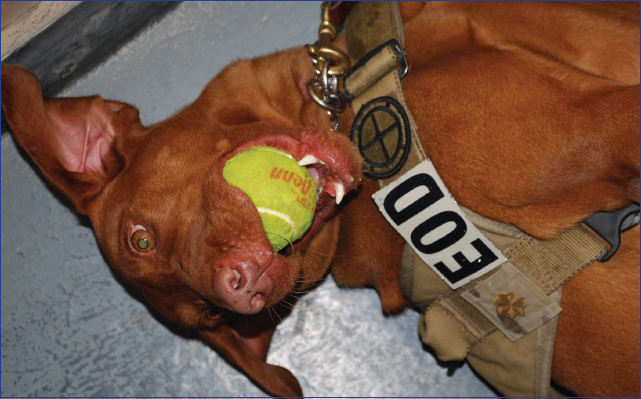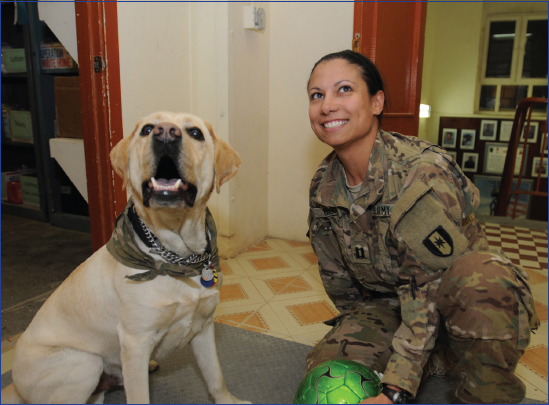No matter which branch they hail from, it’s no secret that many members of the military are not comfortable with opening up or admitting that they’re struggling emotionally as a result of the stress and pressure of their jobs and missions, whether they’re serving stateside or deployed to a war zone. No surprise, since military training has traditionally emphasized that its soldiers keep a stiff upper lip and not show any emotion.
“Everybody is stressed in a war zone,” said Col. David D. Rabb of California, and unit commander for the 113th Combat Stress Control Detachment based in Garden Grove, California. “The question is, how are you going to deal with it? Stress is a silent enemy. It will take you out.”
The one thing that can break the façade and help soldiers to deal with stress often comes in the form of a fellow service member, albeit with four legs, not two, and covered with fur. When military therapists and psychologists watched as some of the most battle-hardened warriors immediately softened up in the presence of a canine soldier, it wasn’t difficult for them to figure that perhaps a four-legged official “therapist” could succeed where a human counterpart had previously failed. Indeed, even the stray dogs that roam around farflung military bases have worked wonders in easing the rigors of deployed life.
And so during the war in Iraq, the military began to recruit canine therapy dogs to serve in war zones specifically to help provide emotional comfort and solace.
Even though many of these dogs come from breeds other than the muscular teeth-baring bite-suit-attacking German shepherds and Belgian Malinois that make up the majority of the military’s canine elite, they still have to go through a similarly rigorous training program, according to Army Capt. Theresa Schillreff, an occupational therapist with the 254th Combat Outpatient Stress Clinic, who worked in Afghanistan alongside a yellow Lab named Major Timmy. “He has been trained to deal with the stress that a dog would endure here,” she said. “For example, he’s been out to firing ranges and has practice getting on and off helicopters with all his safety gear on, including ear muffs and safety goggles.”
A black Labrador retriever named Zeke — with an official rank of Sgt. 1st Class — traveled throughout northern Iraq for two years to bring comfort to thousands of military personnel alongside his human counterpart, Spc. Lawrence Shipman, a patient administrative specialist with the 85th Medical Combat Stress Control Detachment. Shipman marveled at his canine partner’s talent for melting even the most war-hardened soldier.
“Zeke is like an ice-breaker,” said Shipman. “Sometimes people are scared to talk to us, but when they see the therapy dog, soldiers naturally come up to pet him and generally loosen up. Then, most of the time, we are able to talk about anything that is possibly bothering them.”
After returning home from Iraq, Shipman wanted Zeke to retire so he could adopt him, but as is often the case, the Army had other plans. Sgt. 1st Class Zeke calmly accepted his new mission with new handler, Sgt. Paul McCollough, and subsequently headed for Afghanistan. “There are a lot of dog lovers in the military, and whenever Zeke comes around it’s almost like everyone is just not ‘here’ for a few minutes,” said McCollough. “They’re with their dog back home and away from the stressors they have to deal with in this environment.”


In fact, Zeke has been so effective at his job that in 2011 he was inducted into the Order of the Spur, a military organization that honors soldiers who have gone above and beyond the call of duty to serve their fellow soldiers.
The dogs who make it into the MWD elite corps are the cream of the crop; only a small percentage of those who complete training for explosive or drug detection ever make it into the field to work side by side with a human handler.
Canines can wash out of training for a variety of reasons, but one red Lab who flunked out for essentially being too affectionate and sweet happily went on to succeed in another program that fit her personality to a T: therapy dog.
Along with her human partner, Pfc. Alex Fanning, a behavioral health specialist with the 98th Medical Detachment, Major Eden was deployed to Afghanistan in 2013. From the moment they hit the ground they were attracting attention. It didn’t take much: Fanning and Eden often just walked around the base and within minutes soldiers would naturally gravitate towards them, Major Eden serves as a magnet, collecting soldiers as they walk by.

“Our job is to travel around Bagram and to other Forward Operating Bases where members of the 98th are located,” explained Fanning. “We tell people who we are, what we do and what we can do for them. At the same time we let them play with Eden, which brings people to us instead of me just going to them.

“She also helps us get a foot in the door with people because she puts smiles on faces,” he explained. “Then we tell them what we offer and how we can help them out.”
Eden also sits in on individual and group therapy sessions. Fanning regularly conducts a three-day program where soldiers can take a break and talk with a group of therapists about the stress of deployment, pressure from family back home, or anything else they like. Again, Major Eden plays a big role in helping troops to open up, and Fanning has witnessed major breakthroughs with the soldiers he’s worked with. Happily, his own higher-ups have seen it, too. “I’ve talked with generals and colonels who are just so on board with the program,” said Fanning. “They see the difference we make in their soldiers and how happy it makes them. It’s a great feeling to work where I do, watching the troops come in and get the help they need to perform their jobs and knowing we’re really making a difference.”

Another combat stress dog who followed in the pawprints of Sgt. 1st Class Zeke and Major Eden in Afghanistan is a yellow Lab named Major Timmy, who was so good at his job that he was promoted from staff sergeant after only two years of service.
Major Timmy is part of the 528th Medical Detachment’s combat stress control team. Shortly after he arrived to serve at Bagram Airfield in Afghanistan, soldiers and staff came to expect they could always toss a ball or hug a furry neck when they needed a mental health break.
Army Capt. Christine Beck served as Timmy’s handler in his first two years of deployment, and she saw firsthand the almost instantaneous effect that Timmy had on a soldier in a state of shock who had watched as a friend died in front of him. “You could tell in his face that he was still in that numb state,” said Beck. But then he got down on the floor to pet Timmy. “I thought he was going to pet the fur off of him. I could see his face soften up and I could see him almost come out of that state. Then, he started talking about the event and started talking about how hard it was and what a rough week it had been.”


For Spc. Aerick Gomez, a signal support specialist with the 313th Joint Movement Control Battalion, it didn’t take long for him to be convinced of Timmy’s therapeutic talents. “Seeing Timmy gives me a sense of home,” he said. “Timmy is definitely a morale booster. Being able to pet a dog is not the everyday norm in Afghanistan.”
Beck concurs. “The act of petting a dog helps relieve stress,” she said. “Service members play with him, talk to him, or just throw a ball around for a while. It’s a touch from home.” And while soldiers themselves can be reluctant to reach out for help, the same goes for their commanders. “Many times, a commander won’t call for preventative [stress relief] services for their team, but they will call for a Timmy visit.”
Beck reports that one soldier informed her that under normal circumstances he refused to set foot within one hundred meters of her office, but that he made an exception for Major Timmy. “Sometimes they will pet Timmy and talk to Timmy without ever really looking at me,” she said. “But that’s okay because they are getting some outlet and talking to someone.”
While therapy dogs like Major Timmy and Sgt. 1st Class Zeke deploy to military bases around the world and provide an invaluable service to troops and staff overseas, there’s another group that employs dogs in a special way: they greet those who are returning from often lengthy deployments and usually wondering how they’re going to make the transition upon returning home.

Though he lacks an official title, a golden retriever named Lugnut serves an important purpose: as part of the Indianapolis-based group Welcome Home Dogs, Lugnut and his owner, dog trainer Kristi Rush, regularly show up at Camp Atterbury to greet soldiers who are returning from long and possibly traumatic stints overseas. Rush and Lugnut work in several different ways. First, along with a few other dog-and-handler pet-therapy teams from around the area, they’ll show up at the airport to greet soldiers once they first set foot on American soil again. Next, they’ll visit troops who are being demobilized and debriefed while they stay on the base, a process that can often take a week or more and involve numerous examinations to evaluate their physical and mental health as well as filling out mountains of paperwork.
Just like soldiers deployed overseas who smile and visibly relax in the presence of Timmy and Zeke, when Lugnut makes his rounds with the returning troops they exhale and offer up a few smiles. They may even begin to open up a little, telling their stories to a goofy-looking golden retriever with a funny name.
Rush launched Welcome Home Dogs in 2010 because she wanted to share her love for dogs and give something back to local soldiers who had served. “After I’ve witnessed what our dogs can offer to these soldiers who have just come back from overseas, to see them relax and smile and feel the love, my goal has become to get as many teams on board as possible so that we could reach as many of our soldiers as possible,” said Rush. After Lugnut was certified as a therapy dog, Rush started to spread the word to as many dog lovers as she could so she could help even more soldiers. Soon she had six teams certified and ready to contribute.
“I knew immediately that we were a success when I saw the look on the soldiers’ faces,” she said. “They begin to smile. Their bodies shift more in their chairs and their posture becomes more relaxed. They open up and start to talk about their dogs, past, present and future. Hope pours out of them into the dogs and the dogs just swallow it up without question. It never fails to warm my heart to watch our dogs in action.”